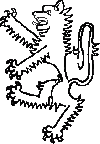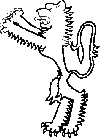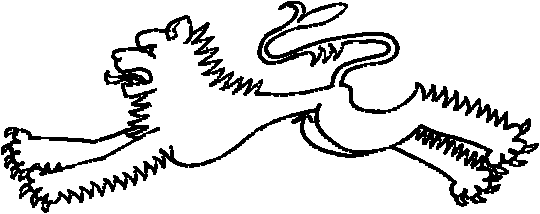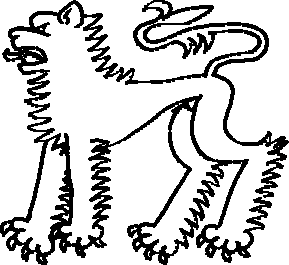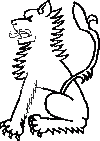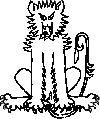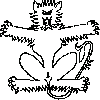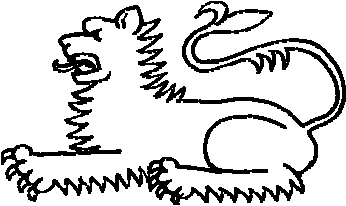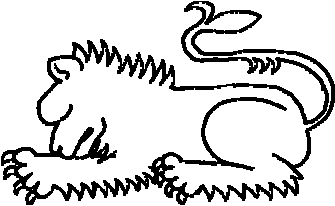Quadruped Postures
WARNING: Do not cite this page as a reference. This page is on this wiki only to make the content "searchable" and easier to find. If you find the information you seek here, go to the original sources as linked below to verify the information and use them for your documentation.
Illustrations:[edit | edit source]
Images from period sources:[edit | edit source]
| 16th | 16th |
| 16th Century German animals issuant from bends or inverted or ? | 16th Century Iberian animals issuant from bends or inverted or ? |
SENA Appendix L:[edit | edit source]
A Partial List of Postures and Orientations This is a list of postures and orientations that can be used to determine whether two charges or groups of charges conflict or whether there is a distinct change for posture/orientation.
Animate Charges A. Quadrupeds: The postures listed within each group generally conflict, though a distinct change may be given for facing to dexter or to sinister.
- rampant, segreant, salient, sejant erect, statant erect
- passant, statant, courant
- sejant, sejant erect
- couchant, dormant
- sejant erect affronty, sejant affronty
http://heraldry.sca.org/laurel/sena.html#AppendixL
Quick Reference - Quadrupeds and Their Postures[edit | edit source]
http://heraldry.sca.org/armory/quadruped-postures.html
Finally, the position of the head, if not looking 'forward', is blazoned explicitly. If the beast is looking at the viewer, it is considered "gardant" and if it is looking back over its shoulder, it is considered "regardant". Thus:
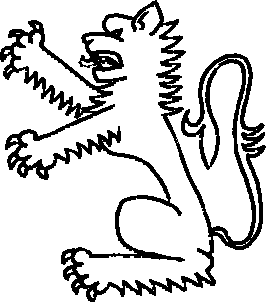 |
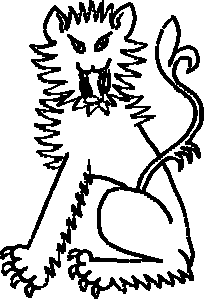 |
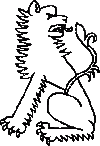
|
| a lion sejant | a lion sejant gardant | a lion sejant regardant |
Other Postures:[edit | edit source]
Clymant = same as salient, used for goats per Parker.
"pascuant or pasquant used of animals when grazing": http://www.burkes-peerage.co.uk/articles/heraldry_p.aspx "Paissant, or Pascuant,=grazing." "Pascuant, (fr.) or Paissant: applied only to cattle grazing with the head touching the ground. If the head is in the usual position statant would be employed." http://www.heraldsnet.org/saitou/parker/Jpglossp.htm
[See 1989 Precedent below for only example of a grazing animal found in O&A on 14 September 2013.]
uluant:specific to canines--wolves in particular--the beast has its head raised as if howling or baying. This is an SCA-invented posture.
<cat> in its curiosity: an SCA-invented and now unregisterable posture used to describe a cat standing on its hind legs with its forelegs on a cauldron as if trying to see or sniff over the edge.
Precedents:[edit | edit source]
Jan 2018 - Putting Dormant to Rest[edit | edit source]
As above, on the October 5, 2017, LoPaD, we asked commenters for commentary to assist submitters in depicting animals dormant, as armory with charges in that posture has frequently been returned for redraw due to lack of identifiability. The intent of the request was that if we considered the examples of dormant found in tracts, we could give definitive guidelines on how to depict beasts dormant in a reliably recognizable manner.
It was noted in the LoPaD that "Dormant is found in period heraldic tracts as a theoretical posture (Legh's Accedens of Armory, 1576, fol.44, attributes Azure, a lion dormant Or to the Tribe of Judah), but one that is not found in actual armory prior to the 17th century." The same posture also appears in Bossewell's Workes of Armorie, 1592. Upon review of both the provided emblazons and descriptions of these tracts, however, it's revealed that the lion of Judah is not in a posture we have been using in the SCA. Legh's depiction of dormant is a variant of his rendering of couchant, with the spine horizontal, forepaws bent, hind legs tucked, tail situated away from the body, and torso lifted up off of the plane formed by the limbs. The only difference is in placement of the head. Rather than situated above the shoulders and perpendicular to the spine, the head extends out parallel to the spine, set just above the paws. Bossewell's lion is in a similar posture, with the head lowered so that its chin touches the top of its forepaws. Neither of them is dormant as submitters have been interpreting it, namely completely at rest and asleep.
The text description of the posture likewise makes it clear that the intent is not to depict an unconscious animal. Legh's tract has the following dialogue between master and student: "Q: Why do ye make him with his eies open & cal him dormant? A: Because isadore sayeth, their slepe is not with close eyen." Bossewelle also cites Isidore, noting "Isidore sayeth, that the Lyons eies are as though he were awake, when he sleapeth. Cum dormient, vigilant oculi."
When animals are depicted in SCA armory as completely asleep, with the silhouette obscured by the limbs tucked into the torso and the head resting against the forepaws, the charge itself often becomes unidentifiable. The depictions of dormant in heraldic tracts allow for identification of the animal, but do not match the popular understanding of the posture, nor do they justify the intent of most submitters to depict an animal with their bodies at rest and sound asleep.
While the College of Arms' policy generally allows for practices that are only attested in heraldic tracts, exceptions to this are made when the practice hinders clarity and identifiability, such as chasing/adumbration. Allowance of the term "dormant" in SCA heraldry has caused consistent hindrance in clarity and identifiability.
After the August 2018 LoAR, use of the term dormant will be discontinued, and armory submissions with asleep or unconscious animals will be returned. Charges in postures following the examples of Legh and Bossewell will be blazoned as couchant, head lowered and registered only if all identifying features are clearly visible in silhouette.
Jan 2018 - quadruped affronty restricted[edit | edit source]
From Wreath: Quadrupeds Affronty On the October 5, 2017, LoPaD, we asked commenters for armorial examples of quadrupeds affronty, to determine whether prior precedent about dragons "displayed" (i.e. statant erect affronty) being a step from period practice should be overturned. The intent of the request was to determine whether quadrupeds affronty were common in period armory. If so, then having a dragon affronty was a natural extension of that pattern and should not be penalized... Based on period examples, the only affronty posture for quadrupeds that is justifiable at all is sejant erect affronty, and even that has only one example that isn't dependent upon circumstances outside the crest itself. Therefore, after the August 2018 LoAR, use of the posture sejant erect affronty will be a step from period practice for non-lions, whether winged or not. All other affronty postures for quadrupeds will be disallowed after the August 2018 LoAR unless documentation is provided. [Thus dragons, being quadrupeds, can no longer be displayed. Wyverns can, being two-legged, per CL defining wyverns vs. dragons, see above.] https://heraldry.sca.org/loar/2018/01/18-01cl.html#5
September 2003 - statant vs courant[edit | edit source]
"There is no difference between statant and courant, because the evidence which has so far been obtained indicates that these postures were interchangeable in period." & "Statant should thus not be given difference from courant, because it was interchangeable with courant in period - just as passant was interchangeable with courant in period." September 2003 LoAR
==May 2002 - inverted animate charges "The SCA has general precedents against registering inverted animate charges unless they are part of a radially symmetrical group such as in annulo. These precedents are on the grounds that such inverted animals are generally not readily identifiable, and they are not found in period heraldry. However, the SCA also has a registration tradition of allowing animals which are usually found in a tergiant posture to be registered in the tergiant inverted posture. "
- "There is very little period evidence for tergiant inverted animals in heraldry."
- "As a result, inverting a tergiant charge is acceptable as long as it does not otherwise violate any basic heraldic principles, including the requirement for identifiability. Because of the lack of period evidence for tergiant inverted charges, the posture will be considered a clear step from period practice (also known informally as a "weirdness") for any charge that cannot be found in this posture in period."
August 2001 - passant vs courant[edit | edit source]
"there should not be a CD between passant and courant" & "There is a significant amount of evidence implying that courant and passant were used interchangeably in English armory." August 2001 LoAR
October 2000 - inverted animals[edit | edit source]
By precedent we do not register inverted animals unless they are part of an arrangement in annulo." October 2000 LoAR
February 1999 - inverted animate charges[edit | edit source]
"We do not allow inverted animate charges in SCA heraldry except when in recognized orientation, such as in annulo." February 1999 LoAR
March 1996 - rear ends[edit | edit source]
The south end of a dragon going north is not a suitable subject for heraldry. You could have a dragon's tail emerging from a cave or from behind a rock ... or a dragon's tail couped and served on a platter for Twelfth Night. But not a dragon's fundament escaping over a wall. (Karina of the Far West, 17 Aug 78, p. 9)
December 1989 - grazing[edit | edit source]
Gizela Balbina Teucer - The following device associated with this name was registered in December of 1989 (via the Outlands): Azure, a gazelle grazing guardant atop a trimount couped, all within a chaplet of thorn Or. [[1]]
November 1982 - dancing[edit | edit source]
"Dancing is not a heraldic position." [Mary Katherine de Macey, November 1982, R-Middle]

